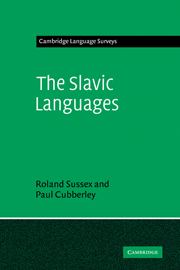Book contents
- Frontmatter
- Contents
- Preface
- Acknowledgments
- map
- 0 Introduction
- 1 Linguistic evolution, genetic affiliation and classification
- 2 Socio-historical evolution
- 3 Phonology
- 4 Morphophonology
- 5 Morphology: inflexion
- 6 Syntactic categories and morphosyntax
- 7 Sentence structure
- 8 Word formation
- 9 Lexis
- 10 Dialects
- 11 Sociolinguistic issues
- Appendix A: Abbreviations
- Appendix B: Orthography and transliteration
- Appendix C: Slavic linguistics: resources
- Bibliography
- Index
5 - Morphology: inflexion
Published online by Cambridge University Press: 22 September 2009
- Frontmatter
- Contents
- Preface
- Acknowledgments
- map
- 0 Introduction
- 1 Linguistic evolution, genetic affiliation and classification
- 2 Socio-historical evolution
- 3 Phonology
- 4 Morphophonology
- 5 Morphology: inflexion
- 6 Syntactic categories and morphosyntax
- 7 Sentence structure
- 8 Word formation
- 9 Lexis
- 10 Dialects
- 11 Sociolinguistic issues
- Appendix A: Abbreviations
- Appendix B: Orthography and transliteration
- Appendix C: Slavic linguistics: resources
- Bibliography
- Index
Summary
Overview
Slavic is a morphology-rich language family, in the mainstream Indo-European tradition, with highly articulated systems of prefixes, roots and suffixes. While Slavic as a whole has a very Indo-European system of synthetic inflexional paradigms, there is some movement towards a more analytic approach in verb and especially nominal morphology, in both national standard languages and regional and social variants. This differentiation of Slavic within the Indo-European language family makes Slavic morphology an area of particular theoretical and empirical interest.
This chapter will concentrate on four aspects of morphology: the morphological categories of Slavic (5.2), morphological word-classes (5.3), the inflexional categories (5.4) and the paradigms for the major inflexional types (5.5).
Morphological categories and structures
The Slavic word consists of one or more roots – the central component of the word – and affixes (prefixes and suffixes), which may accompany the root. For the major categories, the word contains an inflexional suffix, or ending. As this chapter is concerned only with inflexion, we shall simply summarize the other aspects of word structure, with references to chapters 8 and 9 for examples and discussion. Roots can be combined in apposition or by joining with a so-called “link-vowel” -o- (8.1.3, 9.5.2), or by truncation to create so-called “stump compounds” and acronyms, and in mixed formations (8.2.3, 9.5.3).
Slavic also has a wealth of affixes which occur before the root (prefixes) or after the root (suffixes). Prefixes generally modify or add to the root's meaning.
- Type
- Chapter
- Information
- The Slavic Languages , pp. 217 - 308Publisher: Cambridge University PressPrint publication year: 2006

